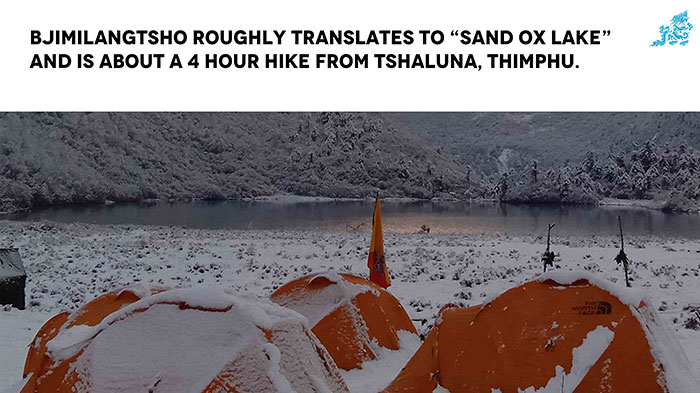Choki Wangmo
I was sitting by the dying embers one early April morning. It was cold. The sun hadn’t come from the mountains when I heard the crunching footsteps on the snow approaching my direction. It was Sonam, a man who provided porter-pony service to the trekking team I was in. He was wide awake and his mouth was stained with doma.
“I couldn’t sleep the whole night. It could be because I told you the legend,” he said, sounding apologetic. “In something like a dream state, an aggressive bull nearly knocked me off. After that, I was waiting for the dawn to break. It was a weird night.”
He looked worried.
The day before, upon my insistence, Sonam narrated the history of Bjimilangtsho, roughly translated as ‘Sand Ox Lake’. He was reluctant. Maybe he was afraid of punishment from the deity of the lake. But I got him narrate the story anyway.
Bjimilangtsho, at an altitude of about 4,000 metres is located about four hour’s hike from Tshaluna in Thimphu. It is midway to Druk Path, one of the best treks in Bhutan that leads trekkers through ancient trading route with spectacular views of rhododendron forests, alpine yak pastures and stunning lakes stocked with snowy mountain trouts. Bjimilangtsho, which spans more than a km is known for giant trout, which were introduced in the 1970s.
According to oral history, a young woman from Tshaluna in Thimphu was herding her cattle in the area. In the past, the place was Tshalups’ popular grazing land. Many took their cattle in the area to graze. One fateful evening, she lost an ox from the herd. Upon reaching home, she was scolded by her family and was sent back to look for the missing beast. When she reached the grazing land, she found the ox sleeping in the current location of the lake. Since it was deep into the night, the girl also spent the night in the place. In the morning, it is said that the ox turned into a lake and the young girl turned into the tshomem (mermaid) of the lake.
“It was her destiny to be here,” Sonam said. “Most lakes in Bhutan dry up in winter. This lake is holy and different. In the past, there were instances where a bull appeared in the lake,” he added proudly.
There are three trails to Bjimilangtsho—high trail from Paro Jela Dzong, Phajoding, and Tshaluna in Thimphu.
The 9-km trail from Tshaluna leads through winding rhododendron and pine forests, with occasional meadows and remains of yak herders’ makeshift huts. To walk along these trails is a constant reminder of how alive everything is in nature’s bosom.
We crossed a number of streams, spring waters, and a creek that ends when you reach the lake. While birds like Black-faced Laughingthrush, White-browed Fulvetta, White-browed Rosefinch, among others, hover on the ground, Hodgson’s Treecreeper hops from one tree to another. Once at the campsite, friendly Large-billed Crow and Spotted Nutcracker came searching for food waste.
People might have settled near the lake in the past. Maybe some hermits came to the area to practice. Here are ruins of houses on the cliff opposite the lake.
Although some in the trekking team said that the lake is ‘friendly’ and ‘mild’ to visitors, others have different opinions.
Lhapchu, a trekking staff, said that the snowfall and blizzard on the previous day was a result of noise and disturbance created by the trekking team. “One should not defile the lake. It is sensitive. One should be careful not to drink and smoke in the area. The tshomem will make the journey difficult for us.”
During tourist season, open defecation is a problem since the camping site is located above the lake.
Deep into the night, I heard the ice breaking off. Sonam, who often travels along the route, said that the intensity of snowfall has changed. It has decreased, like in all other Bhutanese mountains.


